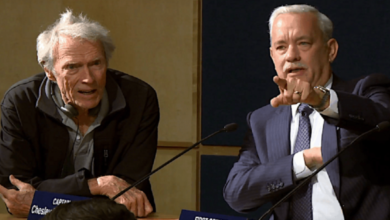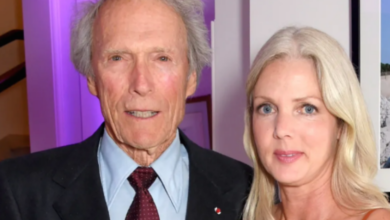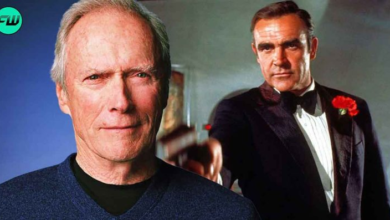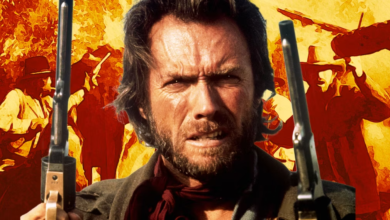Why Clint Eastwood Always Tries To Use The First Take As A Director

Director Stanley Kubrick — in the name of perfection — infamously required his actors to do as many takes as sanity permitted. Actor Philip Stone, who played the ghost of Mr. Grady in “The Shining,” reported to the Independent that to took 50 or 60 takes to shoot a single eight-minute scene. Stone theorized that Kubrick, having come from a background in photography, was far more obsessed with aesthetics than he was with performance, realism, or basic understanding of what actors need to go through. Everything needed to be just so for Kubrick, or the actors would have to do it again.
Standing proudly in contrast to that kind of repeated, weeks-long meticulousness is Clint Eastwood, one of Hollywood’s most notable powerhouses — even without considering his acting career. With 39 directing credits to his name, the 92-year-old filmmaker has long been established as part of the Hollywood firmament.
Eastwood has adopted a directing philosophy that is 100% the opposite of Kubrick’s: Once the lights and the cameras have been set up, Eastwood wants conversations to sound extemporaneous, just like they are in real life. People don’t get “second takes” when it comes to conversation. As such, Eastwood has endeavored to use only one take per scene if possible. He seems to be a very hands-off director, trusting his cast and his crew to provide what they’ve been hired to provide.
In a 2005 interview with Film Comment, Eastwood elucidates on his laidback process.
Everyone just does it
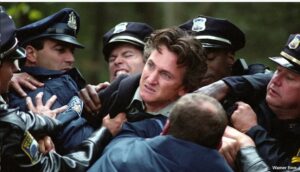
In 2005, Eastwood had already directed 24 features, two of which had won Academy Awards for Best Picture (“Unforgiven” and “Million Dollar Baby”). As such, he had long since become confident that anyone he hired — many of whom he worked with on the regular — already knew what he wanted without too much communication. This unspoken understanding, for Eastwood, greatly streamlined the process, and allowed him to make films quickly and instinctually. Said Eastwood:
“Everyone directs movies differently, but the way I get that is just by doing it. Certain scenes I’ll rehearse if there are technical difficulties of lighting and camera. Fortunately I have a camera crew that’s very well oiled, so they pretty much know where I’m headed, without much explanation. And then, when we get to the point where I’m doing it, no one asks questions when I’m trying to get into the part.”
Eastwood also stresses the need for actors to get on board quickly. Unlike Kubrick, he wasn’t there to rework their performances as infinitum. Eastwood likes a more casual form of conversation, something regular viewers of his films might sense: If there are long speeches in an Eastwood script, they tend to be subdued. Little feels orchestrated in an Eastwood film, and a lot feels improvised. Eastwood had even found that giving actors the constraint of few takes can bring out some great performances.
Spontenaity

Given his broad filmography, Eastwood has naturally worked with hundreds of notable actors in his career, each one of which likely has a different style. Some actors like a theatrical, spontaneous, instinctual form of acting. Others prefer study, rehearsal, careful preparation and repetition. As Eastwood said, he tries to force all his actors into being the former, with, according to him, some rather good results. In Eastwood’s words:
“The objective is to make everything sound like the first time it’s said, so the only thing I can do is try to pick it up the very first time it is said. So a lot of times I’ll do it that way. I know some people don’t like to do that. And if it doesn’t come out perfect the first time, you have to go onward and upward with it. But you’d be surprised with good performers how interesting something can be the first time they try it.”
Eastwood will only do multiple takes, it seems, if the scene requires a little more direction. His elder statesman status, he has seemingly found, has taken the need away from extensive directing. It’s only when Eastwood sees something done beyond his expectations that he’ll need to do another take. Period. No rehash of motivation. It’s all about rhythm and timing. Although Eastwood likely delved and micromanaged early in his directing career, by 2005, not much else was left to be said beyond noting rhythm. As Eastwood said:
“Sometimes the rhythm or the timing isn’t right, so you say let’s do it again with a little more tempo, or let’s not make a moment out of something that shouldn’t be a moment, or let’s make a moment out of something that should be a moment.”
No tension on set
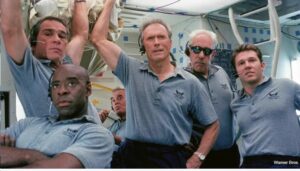
While Eastwood has directed multiple genres of films — thrillers, mood pieces, theological preponderances, musicals (!) — he seems to like the mood on the set to be, in his words, “relaxed.” Eastwood’s directing style stands directly in contrast with his famed personae as an actor; after playing grizzled gunslingers in multiple 1960s westerns and a grizzled, no-nonsense cop in the five “Dirty Harry” movies, Eastwood’s own personality as a soft-spoken square is what shines through in his directing. Again: Those familiar with his directorial career know how mellow — almost frustratingly so — his films can be. Eastwood confirmed this in the Film Comment interview, saying:
“I think that’s what keeps me doing it at this stage in life. It’s that every sequence has its own little challenges. And there are no rules. The rule is whatever it takes. There is no style for every scene. It’s whatever it takes to get there. You have to understand the people. You have to set an atmosphere and a tone where everyone can feel extremely relaxed and there’s no tension to obstruct what you’re trying to do. And it’s amazing what good things will come out of it.”
No tension, no obstructions, no arguments. Eastwood seems to want a set where everyone, y’know, just does the thing. There doesn’t need to be any kind of pretense when you’re two dozen films into your career. His “just do it” philosophy has kept him prolific for decades.
Kubrick, meanwhile, only made 13 features in 47 years.

